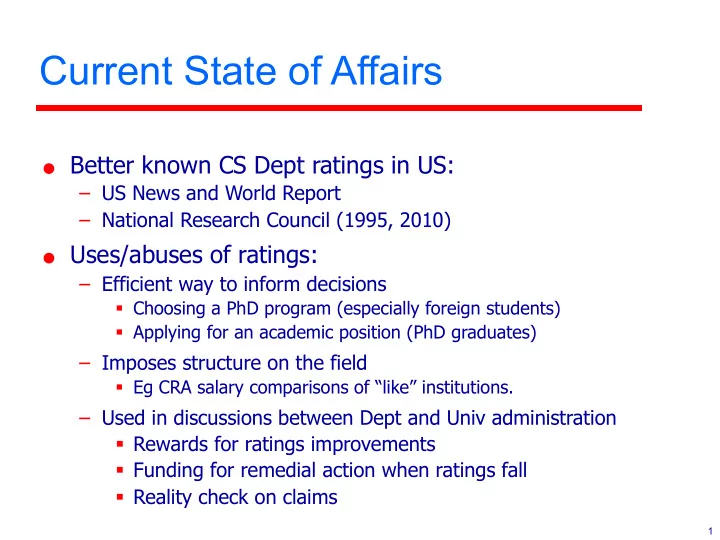

Current State of Affairs Better known CS Dept ratings in US: – US News and World Report – National Research Council (1995, 2010) Uses/abuses of ratings: – Efficient way to inform decisions § Choosing a PhD program (especially foreign students) § Applying for an academic position (PhD graduates) – Imposes structure on the field § Eg CRA salary comparisons of “like” institutions. – Used in discussions between Dept and Univ administration § Rewards for ratings improvements § Funding for remedial action when ratings fall § Reality check on claims 1
Problems with Rating Schemes Trailing indicator Imposes a value system – Different people have different needs and will flourish in different environments Nb: Horror vacui -Parmenides 485BC = “ Nature abhors a vacuum ” Infeasible for our community to decide: There should be no rating system. 2
Ideal Rating Scheme Properties Accuracy : Ratings correlate with what they purport to represent. E.g. § Quality of PhD program § Quality of research § Quality of undergrad program Accuracy implies: Hard to “game” the scheme. Assurance : People have reason to believe the ratings are accurate. § Transparency of process is crucial. Temporal continuity with prior rankings. 3
Ranking Methodology: Inputs Inputs: – Objective data § Publications, grants, size, graduates, graduation rate, … – Subjective data § Who are the authorities? • Per-dept “expert” (=US News and World Report) • Designated “experts” (NRC, UK RAE/REF) § What data do the authorities use? • Gut feeling (=US News and World Report) – Often formed indirectly (grants, newspaper, awards) • Objective documentation provided by subjects (=UK RAE/REF) 4
Ranking Methodology: Outputs Outputs: – Predefined summary statistics: § One or several? E.g., • PhD program quality • Research impact • Undergraduate programs Note: Certain statistics could create or imply a sub-field structure. – Allow users to define “formula”? “If everybody is special, then nobody is.” [ The Incredibles, Pixar Films] – Numeric (w/wo error bars) vs equivalence classes? § Non-ordinal helps prevent spurious inferences. 5
When outsiders rank us … Prima fascia “objective” Lower cost to the field, but there are costs. – Depts still must provide data – Individuals still must provide opinions (1x or 2x rounds) Outsider defines what is important. Likely choice: something that works across many disciplines. – Dimensions of concern: § what are our sub-areas § value systems differ from discipline to discipline: • publications vs “software artifacts” • conference publications vs journal publications § ranking formula(s) coeffecients 6
Questions to Ponder … Are current ranking schemes bad enough to warrant replacement? – How can we determine this? – Can CRA help improve current schemes? – Can CRA develop a scheme that is good enough to be useful? § How might the community agree on what that scheme is? § Can the community afford to implement that scheme? 7
Recommend
More recommend